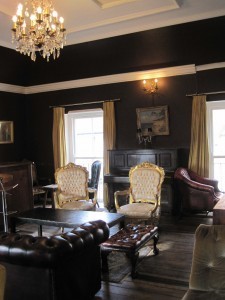Dancing in a Regency ballroom
Last weekend I was in Dorset, a county that can provide a lot of inspiration for a Regency author with the seaside spa of Lyme Regis and the Jurassic coastline so beloved of the 19th  century fossil hunters. We were staying in the town of Bridport, at The Bull Hotel, a fabulous seventeenth century coaching inn complete with sloping floors, low ceilings and lashings of historical atmosphere. You may imagine my excitement when I discovered that The Bull had a ballroom that had been in use in the Georgian and Regency period for those local balls and assemblies we read about in books such as Pride and Prejudice where Lizzy Bennet first set eyes on Mr Darcy. Relatively small ballrooms like this were an important part of the social life of a country town and I had never seen one before but it was just like a scaled down version of the Assembly Rooms in a city like Bath. Here the local gentry families would come to mingle and of course the attendance of a party of newcomers such as Mr Bingley and his sisters and Mr Darcy would cause huge excitement!
century fossil hunters. We were staying in the town of Bridport, at The Bull Hotel, a fabulous seventeenth century coaching inn complete with sloping floors, low ceilings and lashings of historical atmosphere. You may imagine my excitement when I discovered that The Bull had a ballroom that had been in use in the Georgian and Regency period for those local balls and assemblies we read about in books such as Pride and Prejudice where Lizzy Bennet first set eyes on Mr Darcy. Relatively small ballrooms like this were an important part of the social life of a country town and I had never seen one before but it was just like a scaled down version of the Assembly Rooms in a city like Bath. Here the local gentry families would come to mingle and of course the attendance of a party of newcomers such as Mr Bingley and his sisters and Mr Darcy would cause huge excitement!
 Not only was the ballroom at The Bull still recognisably a Regency assembly room but there was also a refreshment room next door (now a cocktail bar), a little withdrawing room for the ladies and a private stair by which the guests could enter the ballroom without having to go through the taproom and less salubrious parts of the inn. I found it easy to slip back in time as I sat sipping my cocktail, and imagined the room full of young ladies in their finery, their matchmaking mamas in tow, and gentlemen in evening dress or uniform… I've posted a couple of photos of the ballroom and refreshment room
Not only was the ballroom at The Bull still recognisably a Regency assembly room but there was also a refreshment room next door (now a cocktail bar), a little withdrawing room for the ladies and a private stair by which the guests could enter the ballroom without having to go through the taproom and less salubrious parts of the inn. I found it easy to slip back in time as I sat sipping my cocktail, and imagined the room full of young ladies in their finery, their matchmaking mamas in tow, and gentlemen in evening dress or uniform… I've posted a couple of photos of the ballroom and refreshment room  here for anyone interested in seeing what a small assembly room in a country town would look like. Apologies that the ballroom pic is a little skew whiff. I was using the wide angle and standing on some steps – and that was after the cocktails!
here for anyone interested in seeing what a small assembly room in a country town would look like. Apologies that the ballroom pic is a little skew whiff. I was using the wide angle and standing on some steps – and that was after the cocktails!
The Bull has an interesting and chequered history. On 14th June 1685, the Duke of Monmouth's forces attacked the King's militia in Bridport. Colonel Venner was shot and wounded by the King's militia from a now bricked-up window of The Bull Hotel. The cocktail bar is named The Venner Room in recognition of this event. A flagstone in the church, set in the chancel floor, also commemorates a William Harvey of Wyke, who died of wounds received at The Bull while fighting with King James's militia during this first shoot-out of Monmouth's rebellion.
Across the street from The Bull was the Old George Inn, now a shop, with lettering around the top that records a visit there by King Charles II on September 3rd 1651 after his defeat at the Battle of Worcester. Charles was apparently almost captured there by Cromwell's troops. The Old George Inn was converted into a pharmacy in the early nineteenth century by Dr Giles L Roberts who developed a popular ointment called "The Poor Man's Friend," the recipe for which is in the Bridport Museum. Bridport has a fascinating history and, perhaps inevitably for a town so close to the South Coast, a history of smuggling in the Georgian period. I loved my visit and the discovery of so many extant Regency features at The Bull, from the ostlers' room to the ballroom, really made my weekend!
©2011 Nicola Cornick. All Rights Reserved.
.


